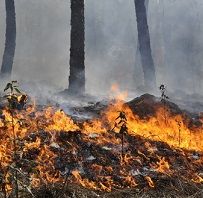News
Article
Effects of Wildfire Smoke: Spotlighting Survey Results from Pediatric Pulmonary Providers
Author(s):
This research expanded upon existing knowledge from pediatric pulmonary providers regarding wildfire smoke risks and prevention.

Most pediatric pulmonary health providers report having experienced caring for and counseling children affected by wildfire smoke in a recent survey of such clinicians in Washington, though few are shown in the same survey to have had instruction in this subject.1
These survey results followed an acknowledgement made by 2021 American Thoracic Society workshop of the necessary role physicians play in working to prevent wildfire smoke exposure damage through communication.2
This new survey research was led by Mary E. Crocker MD, MPH, from the Division of Pulmonary & Sleep Medicine’s Department of Pediatrics University of Washington, Seattle. Smoke damage prevention is known not to be covered in pediatric pulmonology training training, and Crocker and colleagues note that few continuing medical education initiatives have been made to fix this.
“We sought to evaluate the experience and confidence of pediatric pulmonary providers in discussing (wildfire smoke) health risks and prevention strategies in Washington State to understand knowledge gaps and inform strategies to close them,” Crocker and colleagues wrote.
Background and Findings
The investigators enlisted all of the available and active pediatric pulmonology physicians and fellows found in the state of Washington for their survey. The team’s work covered these subjects, working in 4 institutions and a single fellowship program distributed over the whole state.
The research team sent invitations with a link to the survey through the use of email. Once physicians used the link, their eligibility was confirmed. Eligible individuals working as providers would then finish their survey through REDCap.
The investigators criteria for participant inclusion related to current engagement in pulmonary practice or fellowship involving pediatric patients in clinical settings. The team left the survey open for clinician responses from May - July 2023.
The research team’s inquiries in their survey involved data on participant demographics (such as residency, years of experience, the region of participants’ medical school, and fellowship training). They also involved previous formal instruction on wildfire smoke and exposure in clinical settings to pediatric patients impacted by smoke.
The clinicians' confidence in specific wildfire smoke-related areas was looked into through the survey inquiries, and opinions were sought by the investigators on the perceived value of discussing smoke effects in clinical meetings. The team also used descriptive statistics to portray clinicians’ demographic qualities and their response frequencies.
The investigators were given responses from a total of 28 subjects, and this included 7 fellows and 21 practicing pediatric pulmonologists. The research team reported having a response rate of 76% among eligible subjects, with the group ranging from first-year fellows to those with over 15 years of medical experience.
The respondents were shown to have been predominantly from the western US, noting that almost half completed medical school and 3-quarters finished their residency and fellowship in the same area. The team found that most subjects reported recent interactions in which they cared for children impacted by the smoke (96%) and 93% had provided advice on protecting against it.
Despite these results, the investigators showed that only a minority reported having had formal instruction on wildfire smoke, with 32% specifically. None of these respondents were found by the team to have reported receiving wildfire smoke-related training in their time in medical school and few during their pediatric pulmonary fellowship (14%), pediatrics residency (11%), or even as practicing doctors (21%).
The investigators noted that a majority of the survey respondents felt confident in their awareness of the clinical impacts of smoke on these patients, with 82% specifically, and 71% reported identifying those who were shown to be at a higher risk.
The research team reported confidence levels to be substantially lower (32%) in subjects’ understanding of the determination of the Air Quality Index (AQI). They further noted that 25% reported knowledge of where to find reliable information on managing smoke exposure.
Overall, though 93% reported counseling on protecting against such exposures, the team explained that only 36% were found to have reported feeling comfortable doing so, presenting a unique dilemma.
“There is urgent need for a nationwide assessment of the educational needs of pediatric pulmonologists on this issue, as well as swift action to address knowledge gaps,” they wrote. “If given the tools to do so, pediatric pulmonologists are uniquely poised to offer high quality, actionable advice on ways to mitigate the risk for their patients.”
References
- Crocker ME, Cogen JD, Karr CJ. Wildfire smoke knowledge gaps: a survey of pediatric pulmonary providers in Washington State. Pediatr Pulmonol. 2023; 1-4. doi:10.1002/ppul.26835.
- Rice MB, Henderson SB, Lambert AA, et al. Respiratory impacts of wildland fire smoke: future challenges and policy opportunities—an official American Thoracic Society workshop report. Ann Am Thorac Soc. 2021; 18(6): 921-930. doi:10.1513/AnnalsATS.202102-148ST.





